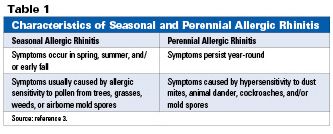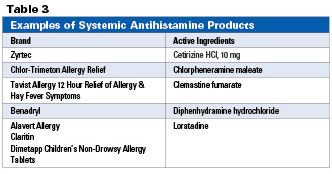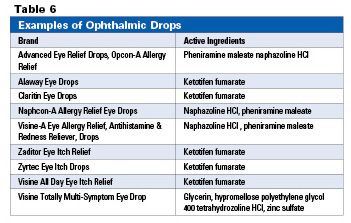OTC Allergy Products: Finding Relief
Allergic rhinitis is common, and its prevalence is on the rise. Pharmacists can counsel patients about their symptoms and recommend OTC products to control them.
Allergic rhinitis is common, and its prevalence is on the rise. Pharmacists can counsel patients about their symptoms and recommend OTC products to control them.
Allergic rhinitis is estimated to affect approximately 60 million individuals in the United States, and its prevalence is increasing.1 This condition affects an estimated 10% to 30% of all adults and as many as 40% of children.1,2 Allergic rhinitis symptoms typically manifest after age 2. Allergic rhinitis is very common among those in the pediatric population, as well as in individuals aged 18 to 64.2 Allergic rhinitis can be classified as seasonal or perennial (see Table 1).2,3

Some individuals may experience both types of rhinitis, with perennial symptoms getting worse during specific pollen seasons.3 In addition, there are also nonallergic causes for rhinitis that can be related to hormones (eg, pregnancy, puberty, thyroid conditions), structural defects (eg, septal deviation, adenoid hypertrophy), lesions (eg, nasal polyps and neoplasms), and the use of certain pharmacologic agents, such as beta-blockers, oral contraceptives, clonidine, angiotensin-converting enzyme inhibitors, aspirin and other nonsteroidal anti-inflammatory drugs, or overuse of topical decongestants.3-6
Allergic rhinitis can be associated with complications such as otitis media, sinusitis, recurring sore throats, cough, headaches, changes in sleep patterns, sleep apnea, depression, fatigue, anxiety, irritability, poor school performance, and impaired cognitive function.3-5 In addition, some children may develop delayed speech, altered facial growth, and dental problems.3-5
Allergic rhinitis is characterized by repetitive and predictable symptoms that include episodes of repetitive sneezing, rhinorrhea, postnasal drip, nasal congestion, loss of smell, headaches, earache, tearing, red, itchy eyes, eye swelling, fatigue, drowsiness, and malaise.2,4
Pharmacologic Therapy
Ideally, the optimal treatment for allergic rhinitis is to avoid the offending allergens; however, that is not always a possible or practical mode of therapy. While allergic rhinitis cannot be cured, the goals of therapy include a reduction in symptoms, improvement in the patient’s ability to function in his or her daily routine, and overall improved well-being.2 Typically allergic rhinitis is treated in 3 steps: environmental control measures and allergen avoidance, pharmacologic therapy, and immunotherapy.2,4 Many patients may have to try several different treatment options before finding one that works for them. Table 2 offers counseling tips for patients with allergic rhinitis.

Antihistamines and Decongestants
Currently, there are a plethora of OTC products available for the symptomatic relief and management of allergic rhinitis, including oral and ocular antihistamines; oral, nasal, and ocular decongestants; and topical mast cell stabilizers.2 These products are available as single-entity or combination products and in sustained release formulations. Selection of therapy should be individualized and based on the patient’s medical and medication history, specific symptoms and their severity, cost of the medications, and frequency of dosing intervals.
Antihistamines are considered to be the top choice for providing symptomatic relief of allergic rhinitis and are indicated for the relief of itching, sneezing, and rhinorrhea symptoms (see Table 3). First-generation antihistamines (sedating antihistamines) are associated with drowsiness or sedation, impaired mental alertness, and anticholinergic effects.2 Second-generation OTC antihistamines (nonsedating antihistamines) currently available include loratadine and cetirizine, and usually do not cause significant drowsiness.2 Patients should start taking antihistamines and mast cell stabilizers at least a week before symptoms typically appear or as soon as possible.2

The available formulations of OTC antihistamines include chewable tablets; oral disintegrating tablets or medicated thin strips; immediate or sustained release capsules, tablets or caplets; and liquid formulas, as well as alcohol-free, sugar-free, and dye-free products.
Since nasal congestion is another common complaint for many allergy sufferers, the use of a systemic or shortterm topical nasal decongestant may be necessary for some individuals.2 Decongestants are indicated for the temporary relief of nasal and Eustachian tube congestion and cough associated with postnasal drip.2 Common adverse effects associated with the use of oral decongestants include insomnia, nervousness, and tachycardia. The use of decongestants may also exacerbate medical conditions that are sensitive to adrenergic stimulation (eg, hypertension, diabetes, coronary artery disease, prostatic hypertrophy, and elevated intraocular pressure).2 Patients should also be reminded about the potential of rhinitis medicamentosa (rebound congestion) when using topical decongestants for more than 3 to 5 days.2
Many products on the market contain a combination of an antihistamine and a decongestant. Patients should be advised to only use combination products when warranted to avoid unnecessary drug use. Since antihistamines and decongestants interact with several medications and are contraindicated in various patient populations, pharmacists are key in identifying potential drug interactions or contraindications.
Cromolyn Sodium
Another option for allergy suffers is the nasal spray cromolyn sodium, which is indicated for preventing and treating the symptoms associated with allergic rhinitis. It is approved for those age 5 and older. Patients should be instructed to administer 1 spray in each nostril 3 to 6 times daily, and treatment should be initiated at least a week before seasonal symptoms occur. The most common adverse effects include a burning and stinging sensation in the nasal area.2,7 There are no known drug interactions associated with intranasal cromolyn sodium.
Ocular Allergies
Patients with allergic rhinitis who also suffer from watery and itchy eyes may benefit from using an ocular antihistamine product. The available ophthalmic OTC antihistamines include pheniramine maleate and antazoline phosphate. These antihistamine products are available in combination with the decongestant naphazoline. The most common adverse effects associated with the use of ophthalmic antihistamines include burning, stinging, and discomfort upon instillation.5
In 2006, the FDA approved ketotifen fumarate 0.025% ophthalmic solution from prescription to OTC status. The newest ketotifen ophthalmic products on the market are Claritin Eye Drops (Schering-Plough) and Zyrtec Eye Drops (McNeil-PPC, Inc). Ketotifen is the only OTC antihistamine ophthalmic product that relieves ocular itching without the use of a decongestant. Ketotifen is a benzocycloheptathiophene derivative and is classified as a noncompetitive H1 receptor antagonist and mast cell stabilizer that inhibits the release of mediators from cells involved in hypersensitivity reactions. 5,8,9 This agent is approved for use in individuals 3 years of age and older and is classified as pregnancy category C.8,9 It is indicated for the temporary relief of itchy eyes due to exposure to ragweed, pollen, grass, animal hair, and dander. The recommended dosage is 1 drop to the affected eye(s) every 8 to 12 hours, but no more than twice daily.5,8,9 The advantages of ketotifen drops include relief within minutes and twice-a-day dosing—it is considered very safe because of no concerns of vasoconstrictor overuse.5,8,9 Common adverse reactions include headache, dry eyes, and rhinitis.5,8,9 Ketotifen is not indicated for treatment of contact lens—related inflammation. Patients who wear contacts should be instructed to wait at least 10 minutes before inserting their lenses after instillation of ketotifen.8,9
Prior to recommending any OTC products for allergic rhinitis, pharmacists should always determine if selftreatment is appropriate and refer individuals to seek further medical evaluation when warranted. The patient’s medication profile and medication history should be screened for potential drug interactions and contraindications, including allergy sensitivities. Patients should always be advised to adhere to the manufacturer’s directions and be aware of potential adverse effects. Pharmacists can also offer suggestions of nonpharmacologic measures, such as the use of nasal saline solutions or the drug-free Breathe Right Nasal Strips (GlaxoSmithKline) and other measures, such as avoidance of allergens when possible; lowering the humidity level in the home to reduce the incidence of mold; keeping car and home windows closed, especially when pollen and mold levels are high; and checking pollen and mold counts in the local area.2 Since peak pollen production occurs between 5 am and 10 am, pharmacists can remind patients to plan outside activities at other times of the day when feasible.10,11 â–
Ms. Terrie is a clinical pharmacy writer based in Haymarket, Virginia.




References
1.
Allergy Statistics America Academy of Allergy Asthma and Immunology website www.aaaai.org/media/statistics/allergy-statistics.asp#allergicrhinitis. Accessed January 24, 2010.
2.
Scolaro K. Disorders Related to Colds and Allergy. In Berardi R, Newton G, McDermott JH, et al, eds. Handbook of Nonprescription Drugs 16th ed. Washington, DC: American Pharmacists Association; 2009. 189-200
3.
Rhinitis .The American Academy of Allergy, Asthma and Immunology website http://www.acaai.org/public/advice/rhin.htm. Accessed January 24, 2010.
4.
Sheikh J and Najib U. Rhinitis, Allergic. eMedicine website. http://emedicine.medscape.com/article/134825-overview. Accessed January 30, 2010.
5.
Fiscella R and Jensen, M. Ophthalmic Disorders. In Berardi R, Newton G, McDermott JH, et al, eds. Handbook of Nonprescription Drugs 16th ed. Washington, DC: American Pharmacists Association; 2009. 526-528
6.
Spring and Allergic Rhinitis. The American Academy of Allergy, Asthma and Immunology website. http://www.aaaai.org/patients/topicofthemonth/0307/. Accessed January 24, 2010
7.
NasalCrom Product Information. Blacksmith Brands website. http://nasalcrom.com. Accessed January 24, 2010.
8.
Zaditor Product Information. Novartis website. http://www.zaditor.com/info/about/zaditor-eye-drops.jsp. Accessed January 24, 2010.
9.
Alaway Product Information. Bausch and Lomb website. http://www.alaway.com/product-information. Accessed January 25, 2010.
10. Outdoor Allergy Tips, Schering Plough Claritin Healthcare Products website, www.claritin.com/claritin/allergies/spring. Accessed January 25, 2010.
11. Allergy Information. Wyeth Consumer website www.alavert.com/allergy_info.asp. Accessed January 25, 2010.

